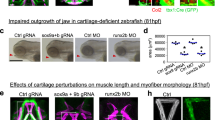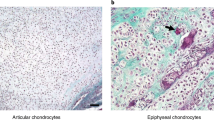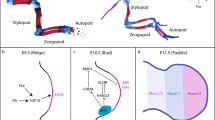Abstract
We standardized conditions for ex vivo mouse limb culture to study cartilage maturation and joint formation. We compared 12.5 d.p.c. mouse forelimbs that were cultured either mounted or freely rotating for up to 72 h. Limb outgrowth progressed ex vivo at a variable rate as compared to its development in vivo, spanning approximately 48 h. Although cartilage maturation and joint formation developed grossly normal, aberrant expression of skeletal marker genes was seen. Interestingly, no regression of the interdigital webs took place in mounted cultures, in contrast to limited webbing under freely rotating conditions. Caspase inhibition, by addition of zVAD-fmk to the culture medium of freely rotating limbs, supported proper gene expression associated with skeletal development, and prevented interdigital web regression. Taken together, a freely rotating ex vivo culture for mouse limb outgrowth that is combined with caspase inhibition provides a good model to study cartilage maturation and joint formation. Cell Death and Differentiation (2001) 8, 985–994
Similar content being viewed by others
Log in or create a free account to read this content
Gain free access to this article, as well as selected content from this journal and more on nature.com
or
Abbreviations
- abc1 :
-
ATP binding cassette transporter-1
- ALP:
-
alkaline phosphatase
- BMP:
-
bone morphogenetic protein
- c1qa :
-
complement component 1qa
- caspase:
-
cysteine aspartic acid specific protease
- col2a1 :
-
collagen type 2a1
- d.p.c.:
-
days post coitum
- gdf5 :
-
growth and differentiation factor-5
- TGF-β:
-
transforming growth factor-β
- TUNEL:
-
terminal deoxynucleotidyl transferase-mediated dUTP-nick end labeling
- zVAD-fmk:
-
benzyloxycarbonyl-Val-Ala-Asp(O-methyl)-fluoromethylketone
References
Martin P . 1990 Tissue patterning in the developing mouse limb Int. J. Dev. Biol. 34: 323–336
Chen Y, Zhao X . 1998 Shaping limbs by apoptosis J. Exp. Zool. 282: 691–702
Dahn RD, Fallon JF . 2000 Interdigital regulation of digit identity and homeotypic transformation by modulated BMP signaling Science 289: 438–441
Hall BK, Miyake T . 2000 All for one and one for all: condensations and the initiation of skeletal development BioEssays 22: 138–147
Dell'Accio F, De Bari C, Luyten FP . 1999 Molecular basis of joint development Jap. J. Rheumatol. 9: 17–29
Francis-West PH, Parish J, Lee K, Archer CW . 1999 BMP/GDF-signalling interactions during synovial joint development Cell. Tissue Res. 296: 111–119
Ng JK, Tamura K, Buscher D, Izpisua-Belmonte JC . 1999 Molecular and cellular basis of pattern formation during vertebrate limb development Curr. Top. Dev. Biol. 41: 37–66
Sandell LJ, Adler P . 1999 Developmental patterns of cartilage Front. Biosci. 4: 731–742
Monsoro-Burq AH, Le Douarin N . 2000 Duality of molecular signaling involved in vertebral chondrogenesis Curr. Top. Dev. Biol. 48: 43–75
Rodriguez-Leon J, Merino R, Macias D, Ganan Y, Santesteban E, Hurle JM . 1999 Retinoic acid regulates programmed cell death through BMP signalling Nat. Cell Biol. 1: 125–126
Dupé V, Ghyselinck NB, Thomazy V, Nagy L, Davies PJA, Chambon P, Mark M . 1999 Essential roles of retinoic acid signaling in interdigital apoptosis and control of BMP-7 expression in mouse autopods Dev. Biol. 208: 30–43
Tsumaki N, Tanaka K, Arikawa-Hirasawa E, Nakase T, Kimura T, Thomas JT, Ochi T, Luyten FP, Yamada Y . 1999 Role of CDMP-1 in skeletal morphogenesis: promotion of mesenchymal cell recruitment and chondrocyte differentiation J. Cell. Biol. 144: 161–173
Sugiura T, Hotten G, Kawai S . 1999 Minimal promoter components of the growth/differentiation factor-5 gene Biochem. Biophys. Res. Commun. 263: 707–713
Storm EE, Kingsley DM . 1996 Joint patterning defects caused by single and double mutations in members of the bone morphogenetic protein (BMP) family Development 122: 3969–3979
Logan C, Francis-West P . 1999 Gene transfer in avian embryos using replication-competent retroviruses. In Methods in molecular biology, Sharpe PT and Mason I, eds Totowa, NJ: Humana Press 539–551
Kengaku M, Capdevila J, Rodriguez-Esteban C, De La Pena J, Johnson RL, Izpisua-Belmonte JC, Tabin CJ . 1998 Distinct Wnt pathways regulating AER formation and dorsoventral polarity in the chick limb bud Science 280: 1274–1277
Lescher B, Haenig B, Kispert A . 1998 sFRP-2 is a target of the Wnt-4 signaling pathway in the developing metanephric kidney Dev. Dyn. 213: 440–451
Leimeister C, Bach A, Gessler M . 1998 Developmental expression patterns of mouse sFRP genes encoding members of the secreted frizzled related protein family Mech. Dev. 75: 29–42
Ladher RK, Church VL, Allen S, Robson L, Abdelfattah A, Brown NA, Hattersley G, Rosen V, Luyten FP, Dale L, Francis-West PH . 2000 Cloning and expression of the Wnt antagonists Sfrp-2 and Frzb during chick development Dev. Biol. 218: 183–198
Milaire J, Mulnard J . 1984 Histogenesis in 11-day mouse embryo limb buds explanted in organ culture J. Exp. Zool. 232: 359–377
Canoun C, Ma C, Halpern D, Shum L, Bringas P, Sank A, Slavkin HC . 1993 Endogenous epidermal growth factor regulates limb development J. Surg. Res. 54: 638–647
Ginsburg GT, Royster D, Kassabian G, Shuler CF, Dougherty WR, Sank AC . 1995 Mesenchymal commitment to digital joint formation Ann. Plast. Surg. 35: 95–104
Stafford DL, Lussier MR, Sank AC, Shuler CF . 1995 In vitro model of syndactyly replicates the morphological features observed in vivo Plast. Reconstr. Surg. 96: 1169–1176
Storm EE, Kingsley DM . 1999 GDF5 coordinates bone and joint formation during digit development Dev. Biol. 209: 11–27
Tang MK, Leung AK, Kwong WH, Chow PH, Chan JY, Ngo-Muller V, Li M, Lee KK . 2000 Bmp-4 requires the presence of the digits to initiate programmed cell death in limb interdigital tissues Dev. Biol. 218: 89–98
Ngo-Muller V, Muneoka K . 2000 Influence of FGF4 on digit morphogenesis during limb development in the mouse Dev. Biol. 219: 224–236
Zeltinger J, Holbrook KA . 1997 A model system for long-term serum-free suspension organ culture of human fetal tissues: experiments on digits and skin from multiple body regions Cell Tissue Res. 290: 51–60
Stevens DA, Williams GR . 1999 Hormone regulation of chondrocyte differentiation and endochondral bone formation Mol. Cell. Endocrinol. 151: 195–204
Väkevä L, Mackie E, Kantomaa T, Thesleff I . 1990 Comparison of the distribution patterns of tenascin and alkaline phosphatase in developing teeth, cartilage, and bone of rats and mice Anta. Rec. 228: 69–76
Cheah KS, Lau ET, Au PK, Tam PP . 1991 Expression of the alpha1(II) collagen gene is not restricted to cartilage during development Development 111: 945–953
Gold R, Schmied M, Giegerich G, Breitschopf H, Hartung HP, Toyka KV, Lassmann H . 1994 Differentiation between cellular apoptosis and necrosis by the combined use of in situ tailing and nick translation techniques Lab. Invest. 71: 219–225
Luciani M-F, Chimini G . 1996 The ATP binding cassette transporter ABC1 is required for the engulfment of corpses generated by apoptotic cell death EMBO J. 15: 226–235
Wood W, Turmaine M, Weber R, Camp V, Maki RA, McKercher SR, Martin P . 2000 Mesenchymal cells engulf and clear apoptotic footplate cells in macrophageless PU.1 null mouse embryos Development 127: 5245–5252
Botto M, Dell'Agnola C, Bygrave AE, Thompson EM, Cook HT, Petry F, Loos M, Pandolfi PP, Walport MJ . 1998 Homozygous C1q deficiency causes glomerulonephritis associated with multiple apoptotic bodies Nat. Genet. 19: 56–59
Earnshaw WC, Martins LM, Kaufmann SH . 1999 Mammalian caspases: structure, activation, substrates, and functions during apoptosis Annu. Rev. Biochem. 68: 383–424
Zhu H, Fearnhead HO, Cohen GM . 1995 An ICE-like protease is a common mediator of apoptosis induced by diverse stimuli in human monocytic THP.1 cells FEBS Lett. 374: 303–308
Fearnhead HO, Dinsdale D, Cohen GM . 1995 An interleukin-1β-converting enzyme-like protease is a common mediator of apoptosis in thymocytes FEBS Lett. 375: 283–288
Mitrovic D . 1982 Development of the articular cavity in paralyzed chick embryos and in chick embryo limb buds cultured on chorioallantoic membranes Acta Anat. (Basel) 113: 313–324
Persson M . 1983 The role of movements in the development of sutural and diarthrodial joints tested by long-term paralysis of chick embryos J. Anat. 137: 591–599
Hosseini A, Hogg DA . 1991 The effects of paralysis on skeletal development in the chick embryo. I. General effects J. Anat. 177: 159–168
Zakeri Z, Guaglino D, Ahuja HS . 1994 Apoptotic cell death in the mouse limb and its suppression in the hammertoe mutant Dev. Biol. 165: 294–297
Ahuja HS, James W, Zakeri Z . 1997 Rescue of the limb deformity in hammertoe mutant mice by retinoic acid-induced cell death Dev. Dyn. 208: 466–481
Clark RM, Marker PC, Kingsley DM . 2000 A novel candidate gene for mouse and human preaxial polydactyly with altered expression in limbs of hemimelic extra-toes mutant mice Genomics 67: 19–27
Cecconi F, Alvarez-Bolado G, Meyer BI, Roth KA, Gruss P . 1998 Apaf1 (CED-4 homolog) regulates programmed cell death in mammalian development Cell 94: 727–737
Yoshida H, Kong Y-Y, Yoshida R, Elia AJ, Hakem A, Hakem R, Penninger JM, Mak TW . 1998 Apaf1 is required for mitochondrial pathways of apoptosis and brain development Cell 94: 739–750
Chautan M, Chazal G, Cecconi F, Gruss P, Golstein P . 1999 Interdigital cell death can occur through a necrotic and caspase-independent pathway Curr. Biol. 9: 967–970
Schotte P, Declercq W, Van Huffel S, Vandenabeele P, Beyaert R . 1999 Non-specific effects of methyl ketone peptide inhibitors of caspases FEBS Lett. 442: 117–121
Milligan CE, Prevette D, Yaginuma H, Homma S, Cardwell C, Fritz LC, Tomaselli KJ, Oppenheim RW, Schwartz LM . 1995 Peptide inhibitors of the ICE protease family arrest programmed cell death of motoneurons in vivo and in vitro Neuron 15: 385–393
Jacobson MD, Weil M, Raff MC . 1996 Role of Ced-3/ICE-family proteases in staurosporine-induced programmed cell death J. Cell. Biol. 133: 1041–1051
Lee KK, Tang MK, Yew DT, Chow PH, Yee SP, Schneider C, Brancolini C . 1999 Gas2 is a multifunctional gene involved in the regulation of apoptosis and chondrogenesis in the developing mouse limb Dev. Biol. 207: 14–25
Salas-Vidal E, Lomeli H, Castro-Obregon S, Cuervo R, Escalante-Alcalde, Covarrubias L . 1998 Reactive oxygen species participate in the control of mouse embryonic cell death Exp. Cell Res. 238: 136–147
Hopkinson-Woolley J, Hughes D, Gordon S, Martin P . 1994 Macrophage recruitment during limb development and wound healing in the embryonic and foetal mouse J. Cell Sci. 107: 1159–1167
Savill J, Fadok V . 2000 Corpse clearance defines the meaning of cell death Nature 407: 784–788
Hamon Y, Broccardo C, Chambenoit O, Luciani M-F, Toti F, Chaslin S, Freyssinet J-M, Devaux PF, McNeish J, Marguet D, Chimini G . 2000 ABC1 promotes engulfment of apoptotic cells and transbilayer redistribution of phosphatidylserine Nat. Cell Biol. 2: 399–406
Stewart S, Yi S, Kassabian G, Mayo M, Sank A, Shuler C . 2000 Changes in expression of the lysosomal membrane glycoprotein, LAMP-1 in interdigital regions during embryonic mouse limb development, in vivo and in vitro Anat. Embryol. 201: 483–490
Haaijman A, D'Souza RN, Bronckers ALJJ, Goei SW, Burger EH . 1997 OP-1 (BMP-7) affects mRNA expression of type I, II, X collagen, and matrix gla protein in ossifying long bones in vitro J. Bone Miner. Res. 12: 1815–1823
Hargrave M, Koopman P . 2000 In situ hybridization of whole-mount embryos. In Methods in molecular biology, Darby IA, ed Totowa, NJ: Humana Press 279–289
Acknowledgements
The authors thank Dr. Suneel Apte (Cleveland Clinic Foundation, Cleveland, OH, USA) and Dr. Paul Martin (University College London, London, UK) for the generous gifts of col2a1, abc1 and c1qa cDNAs (courtesy of Dr. Giovanna Chimini and Dr. Marina Botto). Dr. An Zwijsen (Laboratory for Molecular Biology and Flanders Interuniversity Institute for Biotechnology) is acknowledged for laboratory animal facility service and assistance to the procedure of whole mount in situ hybridization. We thank Jenny Peeters and Giselle De Geest (Center for Human Genetics and Flanders Interuniversity Institute for Biotechnology) for technical advice on tissue sectioning. Dirk De Valck is a postdoctoral research assistant with the Fund for Scientific Research-Flanders. Research was supported by the Fund for Scientific Research-Flanders (grant nr G.0200.99) and the National Lottery (grant nr 9.0200.99).
Author information
Authors and Affiliations
Corresponding author
Additional information
Edited by M Piacentini
Rights and permissions
About this article
Cite this article
De Valck, D., Luyten, F. Caspase inhibition supports proper gene expression in ex vivo mouse limb cultures. Cell Death Differ 8, 985–994 (2001). https://doi.org/10.1038/sj.cdd.4400912
Received:
Revised:
Accepted:
Published:
Issue date:
DOI: https://doi.org/10.1038/sj.cdd.4400912
Keywords
This article is cited by
-
Caspases and osteogenic markers?in vitro screening of inhibition impact
In Vitro Cellular & Developmental Biology - Animal (2016)
-
Dynamics of caspase-3 activation and inhibition in embryonic micromasses evaluated by a photon-counting chemiluminescence approach
In Vitro Cellular & Developmental Biology - Animal (2012)



